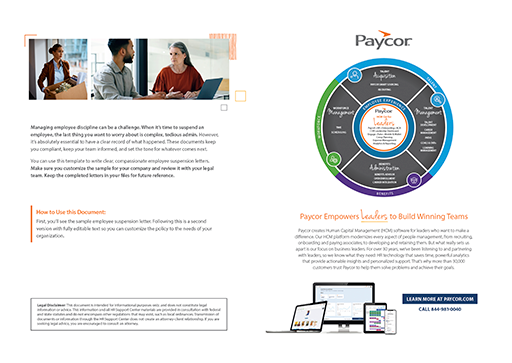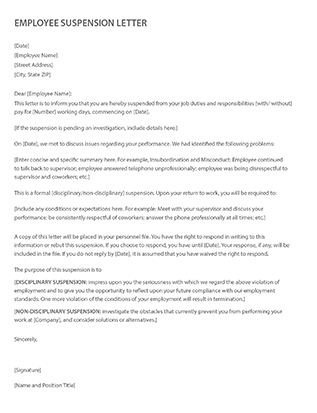Employee Suspension Letter Template
Managing employee discipline can be a challenge. On the one hand, it’s HR’s job to support employees even when they’re struggling. On the other hand, you also have to enforce standards and uphold company policy. Employee suspension is never a first step, but sometimes it’s unavoidable. When that happens HR should follow certain steps to protect the company from legal and compliance issues.
In this article, we’ll cover the whole process: when, why, and how to suspend an employee, including specific processes for HR.
When to Suspend an Employee
If an employee makes repeated mistakes or intentionally breaks company rules, they probably need help. At first, approach them in good faith. Maybe they don’t know about a certain rule, or they’re dealing with problems at home. In many cases, a quick conversation with a supervisor is enough to fix things. If not, you may have to escalate the issue. Here’s how:
Problematic Behavior
The employee repeatedly makes mistakes or breaks company rules.
Clear Documentation
Keep a written record of any issue, including dates, context, and the names of anyone involved.
Constructive Feedback
The employee’s direct supervisor talks to them about the problem.
Escalation to HR
If the situation doesn’t improve, they meet with HR to discuss solutions.
At this point, they might go on a Performance Improvement Plan (PIP).
A Chance to Improve
HR should specify a timeline. Check in on a set date to evaluate their progress.
Suspension
If the problem persists, it’s time to suspend the employee.
Action Plan
Tell the employee what you expect to change when they return.
Termination of Employment
If the employee fails to improve after suspension, it may be time to let them go.
Think of these steps as a gradual escalation. The problem could get resolved at any point in the process. Do your best to stay open to that possibility. People are more likely to improve when they feel supported and heard.
Reasons to Suspend an Employee
At the core, there are two reasons you might need to suspend an employee:
- Disciplinary Measure: The person’s poor performance interferes with their work, their coworkers’ work, or the company’s goals. Even annoyances like perpetual tardiness can turn into serious issues over time. Bigger problems, like workplace harassment, may require more immediate attention.
- Non-Disciplinary Issues: Sometimes, you might suspend an employee for reasons that aren’t their fault. For example, if they have a medical condition that makes work unsafe, HR can mandate that they go on leave for a certain suspension period.
In either situation, it’s important to set a clear timeline for their suspension, including criteria for their return to work. For example, you might suspend an employee for five days. Alternatively, you could suspend them pending an investigation of their actions or the work environment.
No matter why you need to suspend an employee, make sure you review local and federal laws before taking action. They might be entitled to pay, continued health insurance, or other benefits during their absence. Laws vary widely between U.S. states.
How to Draft an Employee Suspension Letter
When you suspend an employee, communication is key. It sets clear expectations, provides a record of HR’s decisions, and sets the tone for whatever comes next. This is your chance to model kind, professional behavior even during conflict. If all goes well, the employee will follow your example. Here’s how to approach the conversation:
- Draft their suspension notice.
- Have a face-to-face conversation, either in person or over a video call. Let them know they can expect to receive a letter as soon as the conversation ends.
- Share the official letter immediately, with as little lag time as possible.
The letter is an official document that goes in the employee’s personnel file. You should also share it with their direct supervisor. While it will likely protect you from compliance issues, be prepared to share it with your legal team if necessary. It should include:
- The exact date(s) of the suspension. If the suspension is pending an investigation, mention that in your notes.
- Specific reasons for suspension, citing past incidents, warnings, and failures to improve.
- Explanation of how the employee breached company policy.
- Include as much context as you can.
- Whether the suspension is paid or unpaid, its impact on benefits, etc.
- Reminder of the employee’s right to respond.
- Reminder of your company’s grievance procedures.
- A clear statement that if these issues continue after suspension, you may terminate employment.
Don’t assume your reader has any background information. The employee probably has some ideas about why they’re getting suspended, but they’re not the only person who will see this document. Explain the situation as clearly, formally, and factually as you can. By using a template, you’ll ensure all your company’s employee suspension notices are consistent.
Write Your Employee Suspension Letter
When it’s time to suspend a team member, the last thing you want to worry about is time-consuming admin. It’s far better to have an employee suspension letter sample ready to go. Download the template, customize it for your company, and trust it will be there if you need it.











